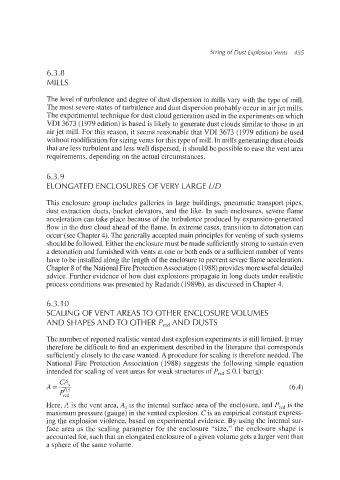Page 488 - Dust Explosions in the Process Industries
P. 488
Sizing of Dust fxplosion Venfs 455
6.3.8
MILLS
The level of turbulence and degree of dust dispersion in mills vary with the type of mill.
The most severe states of turbulence and dust dispersion probably occur in air jet mills.
The experimental technique for dust cloud generation used in the experiments on which
VDI 3673 (1979 edition) is based is likely to generate dust clouds similar to those in an
air jet mill. For this reason, it seems reasonable that VDI 3673 (1979 edition) be used
without modification for sizing vents for this type of mill. In mills generating dust clouds
that are less turbulent and less well dispersed, it should be possible to ease the vent area
requirements, depending on the actual circumstances.
6.3.9
ELONGATED ENCLOSURES OF VERY LARGE LID
This enclosure group includes galleries in large buildings, pneumatic transport pipes,
dust extraction ducts, bucket elevators, and the like. In such enclosures, severe flame
acceleration can take place because of the turbulence produced by expansion-generated
flow in the dust cloud ahead of the flame. In extreme cases, transition to detonation can
occur (see Chapter 4). The generally accepted main principles for venting of such systems
should be followed. Either the enclosure must be made sufficiently strong to sustain even
a detonation and furnished with vents at one or both ends or a sufficient number of vents
have to be installed along the length of the enclosure to prevent severe flame acceleration.
Chapter 8 ofthe National Fire ProtectionAssociation (1988)provides more useful detailed
advice. Further evidence of how dust explosions propagate in long ducts under realistic
process conditions was presented by Radandt (l989b), as discussed in Chapter 4.
6.3.1 0
SCALING OF VENT AREA5 TO OTHER ENCLOSURE VOLUMES
AND SHAPES AND TO OTHER PredAND DUSTS
The number of reported realistic vented dust explosion experiments is still limited. It may
therefore be difficult to find an experiment described in the literature that corresponds
sufficiently closely to the case wanted. A procedure for scaling is therefore needed. The
National Fire Protection Association (1988) suggests the following simple equation
intended for scaling of vent areas for weak structures of Pred5 0.1 bar(g):
Here, A is the vent area, A, is the internal surface area of the enclosure, and Predis the
maximum pressure (gauge) in the vented explosion. Cis an empirical constant express-
ing the explosion violence, based on experimental evidence. By using the internal sur-
face area as the scaling parameter for the enclosure “size,” the enclosure shape is
accounted for, such that an elongated enclosure of a given volume gets a larger vent than
a sphere of the same volume.

